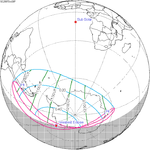Solar eclipse of April 10, 2089: Difference between revisions
Content deleted Content added
m Update after template merger |
m Replace template per TFD outcome; no change in content |
||
| Line 1: | Line 1: | ||
{{Infobox solar eclipse|2089Apr10}} |
{{Infobox solar eclipse|2089Apr10}} |
||
An [[Annulus (mathematics)|annular]] [[solar eclipse]] will occur on April 10, [[2089]]. A [[solar eclipse]] occurs when the [[Moon]] passes between [[Earth]] and the [[Sun]], thereby totally or partly obscuring the image of the Sun for a viewer on Earth. An annular solar eclipse occurs when the Moon's [[apparent diameter]] is smaller than the Sun's, blocking most of the Sun's light and causing the Sun to look like an [[Annulus (mathematics)|annulus]] (ring). An annular eclipse appears as a partial eclipse over a region of the Earth thousands of kilometres wide.[[Category:Annular solar eclipses]] |
|||
An [[Annulus (mathematics)|annular]] [[solar eclipse]] will occur on April 10, [[2089]]. {{Annular solar eclipse summary}} |
|||
== Related eclipses== |
== Related eclipses== |
||
Revision as of 00:05, 26 April 2015
| Solar eclipse of April 10, 2089 | |
|---|---|
| Type of eclipse | |
| Nature | Annular |
| Gamma | −0.3319 |
| Magnitude | 0.9919 |
| Maximum eclipse | |
| Duration | 53 s (0 min 53 s) |
| Coordinates | 10°12′S 154°48′W / 10.2°S 154.8°W |
| Max. width of band | 30 km (19 mi) |
| Times (UTC) | |
| Greatest eclipse | 22:44:42 |
| References | |
| Saros | 140 (33 of 71) |
| Catalog # (SE5000) | 9708 |
An annular solar eclipse will occur on April 10, 2089. A solar eclipse occurs when the Moon passes between Earth and the Sun, thereby totally or partly obscuring the image of the Sun for a viewer on Earth. An annular solar eclipse occurs when the Moon's apparent diameter is smaller than the Sun's, blocking most of the Sun's light and causing the Sun to look like an annulus (ring). An annular eclipse appears as a partial eclipse over a region of the Earth thousands of kilometres wide.
Related eclipses
Solar eclipses 2087-2090
This eclipse is a member of a semester series. An eclipse in a semester series of solar eclipses repeats approximately every 177 days and 4 hours (a semester) at alternating nodes of the Moon's orbit.[1]
| 120 | May 2, 2087 Partial |
125 | October 26, 2087 Partial |
| 130 | April 21, 2088 Total |
135 | October 14, 2088 Annular |
| 140 | April 10, 2089 Annular |
145 | October 4, 2089 Total |
| 150 | March 31, 2090 Partial |
155 | September 23, 2090 Total |
Notes
- ^ van Gent, R.H. "Solar- and Lunar-Eclipse Predictions from Antiquity to the Present". A Catalogue of Eclipse Cycles. Utrecht University. Retrieved 6 October 2018.
References
- Earth visibility chart and eclipse statistics Eclipse Predictions by Fred Espenak, NASA/GSFC
Wikimedia Commons has media related to Solar eclipse of 2089 April 10.




